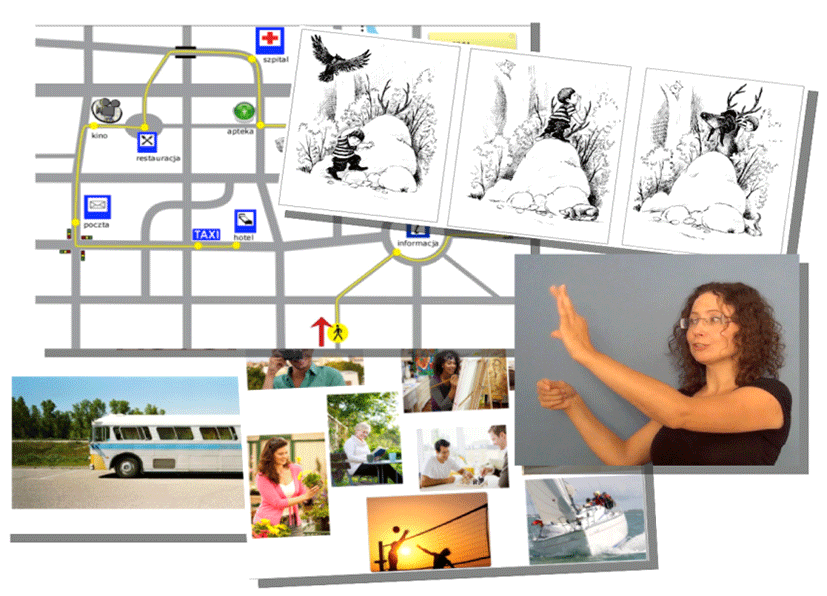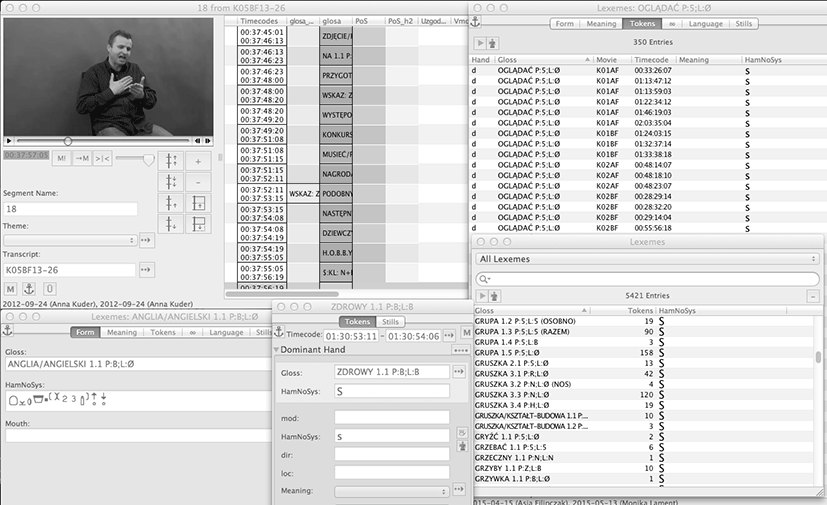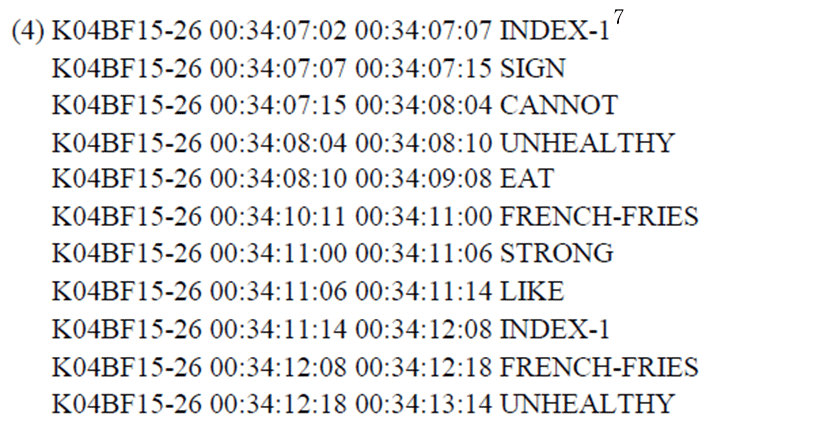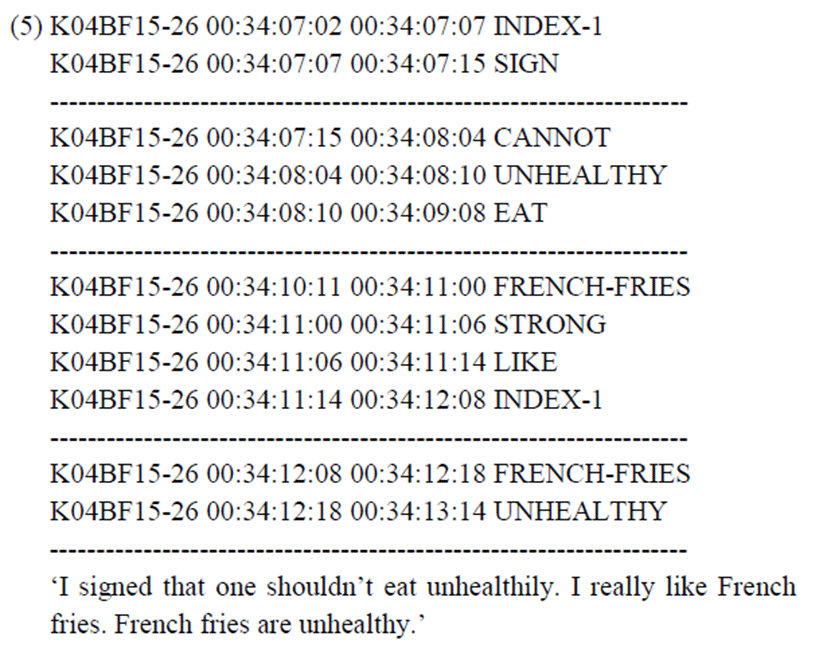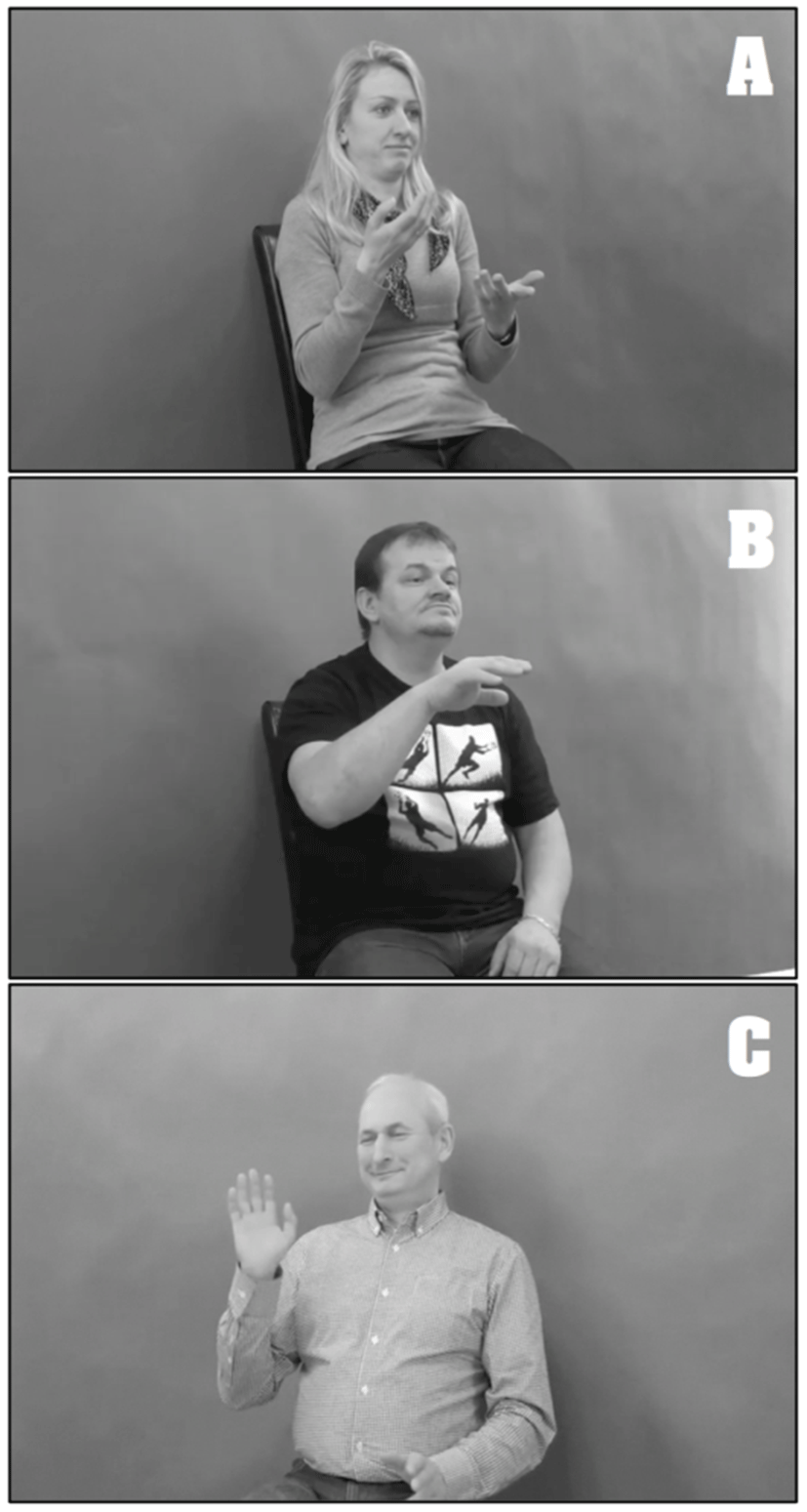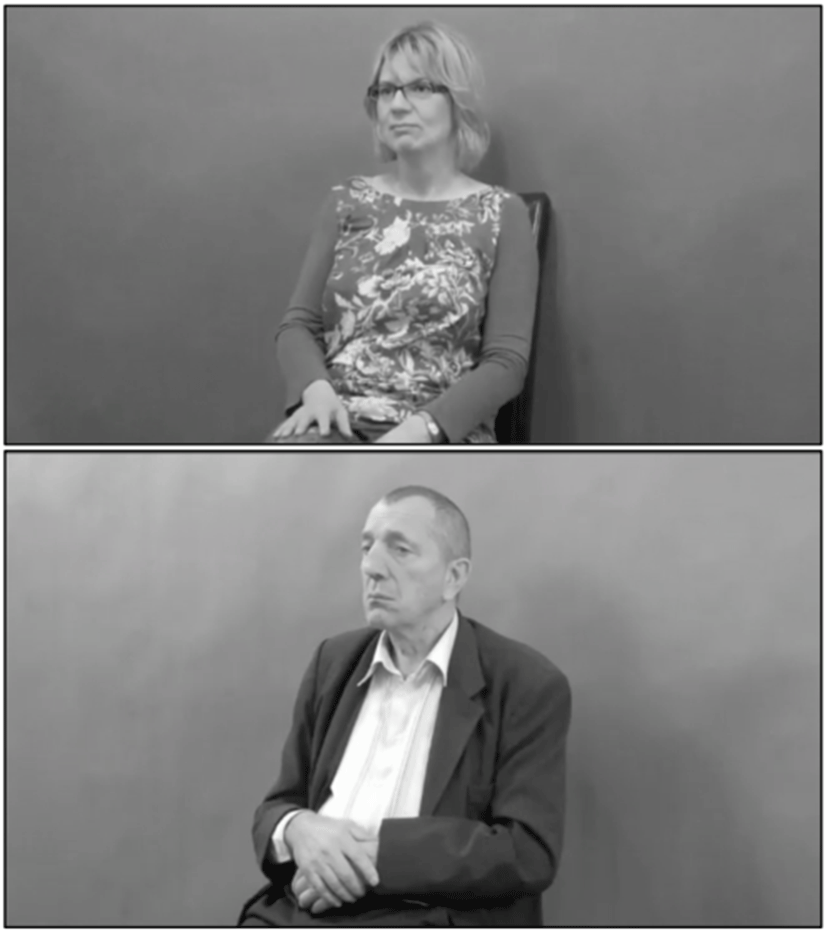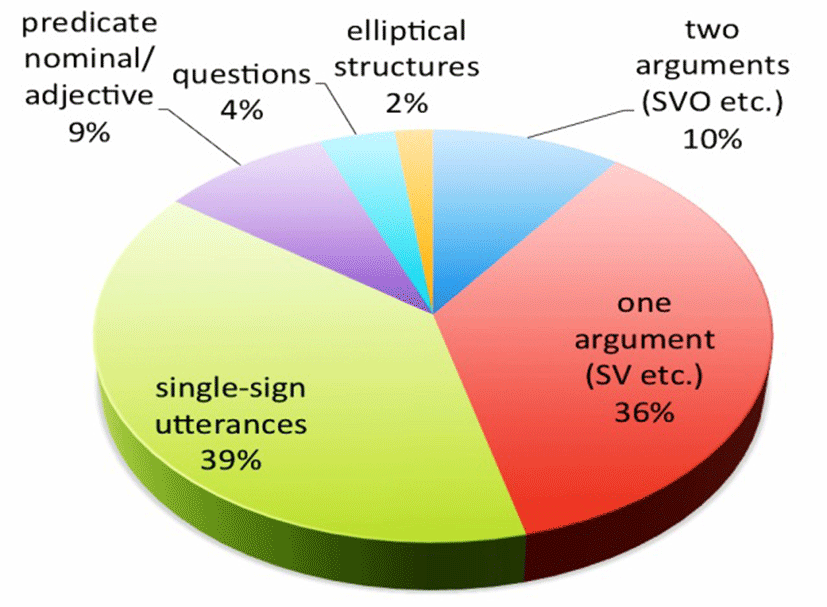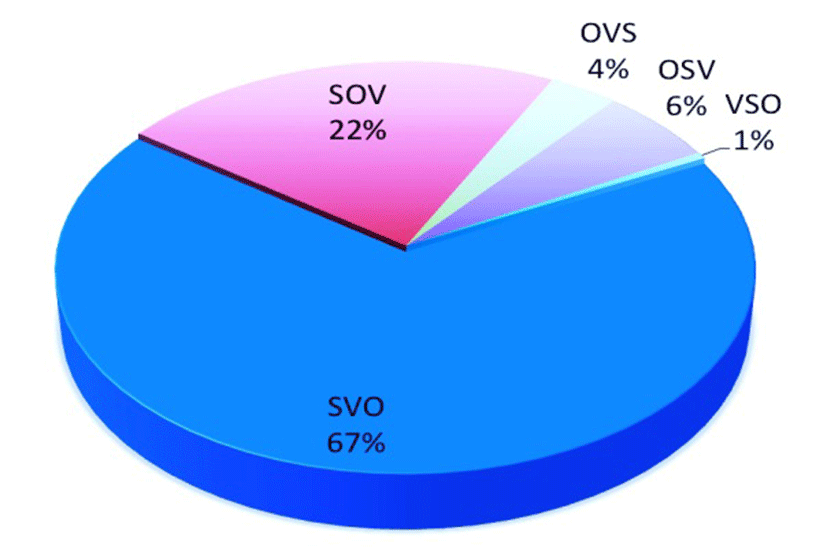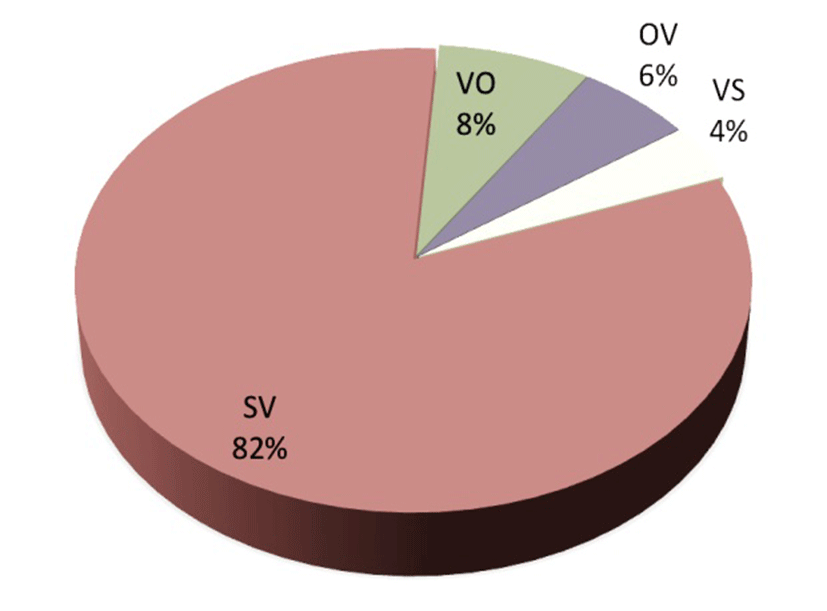1. Introduction
Much of recent linguistic literature on the communication of the Deaf1 attempts to investigate to what extent sign languages may be claimed to derive from the same set of (possibly universal) principles that underlies grammars of spoken languages (see, e.g., Sandler & Lillo-Martin 2006). Undoubtedly, sign languages differ from spoken languages in terms of many aspects of syntax. The key difference relates to the visual-spatial modality: signed constructions may be three-dimensional, rather than strictly linear. However, this observation does not necessarily imply that the universal typology of sentential word orders (e.g., Dryer 2013) is not applicable to the languages of the Deaf. The aim of this paper is to discuss certain word order properties of Polish Sign Language (polski język migowy, usually abbreviated as PJM). The issue of sentence structure has been discussed in the sign language literature since the 1970s (cf. e.g., Fischer 1975, Friedman 1976) but analyses of this aspect of the syntax of PJM have been few and far between. Our work attempts to fill that gap on the basis of data extracted from a newly created corpus of PJM.2
2. What is PJM?
PJM is a natural language used by the Deaf community in Poland, currently by more than 50,000 signers. PJM is genetically unrelated to Polish and to other spoken languages. This minority language started to evolve around 1817, with the foundation of the first school for the deaf — the Institute for the Deaf-Mute and the Blind in Warsaw.
A vast majority of today’s specialists agree that sign languages are functionally equivalent to spoken languages and that the cognitive basis of the manual-gestural communication of the Deaf is not significantly different from that of the spoken language of the hearing (see, e.g., Emmorey 2002). From the perspective of modern Polish linguistics, however, this unanimity is quite recent. Historically, signing was often considered inferior to using spoken Polish. Treated, at best, as a visual aid to lip-reading, PJM was for many decades deprived of the status of a full-fledged natural language. In recent years, this approach has started to change, as is evidenced by a newly passed Polish law on sign language and other means of communication, which, among other measures, grants the Deaf community new rights concerning interpreting services in contacts with public administration. However, PJM is still a heavily understudied language. Rigorous academic research on its grammar and vocabulary only began in the 1990s (cf. Rutkowski & Sak 2016).
The grammatical structure of PJM is fully independent of that of spoken Polish. This can be illustrated by juxtaposing the following two questions:
These two short sentences exemplify the range of differences that may be seen when comparing the two linguistic systems in question: what distinguishes PJM from Polish is not only the visual-gestural modality, but also the choice of lexical elements used in particular semantic contexts (e.g., ‘years’ versus ‘life’ when asking somebody’s age in (1-2)) and, crucially, word order rules (e.g., the initial versus final placement of a question word). Additionally, the issue of three-dimensionality/simultaneity may come into play, for instance the question in (2) is sometimes linearized as in (3):
The above structure is a very clear example of how different articulators can be used simultaneously in a sign language utterance. Three linguistic signals are produced at the same time: the lexical signs LIFE and HOW-MUCH and the non-manual squint. It needs to be emphasized that PJM, like other sign languages, is articulated with the signer’s whole body, and not only with the hands. The non-manual articulatory features of visual-spatial languages include body movements, facial expressions, eye gaze, actions of the mouth, nose, brows, and cheeks (cf. Crasborn 2012). Each of these components may play an important role in a PJM utterance. They not only distinguish between different uses of lexical signs but also function as markers of grammatical functions (e.g., in questions, negative sentences or imperatives, cf. Pfau & Quer 2010).
Any description of the grammar of PJM has to take into account the above-mentioned issues of spatiality (the fact that all signs are produced in the three-dimensional signing space) and simultaneity (signed utterances need not be strictly linear). This, however, does not imply that PJM lacks any rules as to how linear sequences of signs should be formed. As will be shown below, typological analyses of major constituent ordering that are based on spoken languages are also applicable to sign languages.
3. Word Order in Sign Languages
As noted by Dryer (2011), of the six possible linearizations of arguments with respect to the main verb, only three are commonly found in the world’s languages: SOV (subject-object-verb, 41% of analyzed languages), SVO (subject-verb-object, 35.4%), and VSO (verb-subject-object, 6.9%). The remaining three possible orders (OSV, OVS, and VOS) are very rare (from 0.3% to 1.8% of analyzed languages; see also Odden’s (2003) discussion of the rareness of OSV, OVS, and VOS). In other words, 75% of the world’s languages use SOV or SVO, the next most frequent type is characterized by the absence of a basic word order (13.7%).
Interestingly, SVO and SOV are also the most frequent basic word orders in sign languages. As pointed out by Perniss, Pfau & Steinbach (2007: 15), there seems to be no sign language displaying the VSO order. Sign languages analyzed as belonging to the SVO type include American Sign Language, Taiwanese Sign Language, and Brazilian Sign Language, whereas SOV is reported to be the basic word order for, e.g., Austrian Sign Language, German Sign Language, and Japanese Sign Language (Sandler & Lillo-Martin 2006: 297).
Although a significant number of sign languages have already been described as either SVO or SOV, many researchers point out that identifying the underlying order of sentential constituents in a sign language is far from straightforward (see Leeson & Saeed 2012). Some linguists even argue that sign languages cannot be claimed to have a basic word order, only a most frequent one (Friedman 1976).5 Others say that word order is often variable and depends on various factors like the type of the verb used in a given sentence (Fischer 1975, Valli et al. 2011), the aspectual interpretation of the verb (Liddell 1980) or the locative setting (De Weerdt 2008).
As for PJM, the issue of sentential constituent ordering has not yet been properly researched. The earliest known grammatical description of PJM (Hollak & Jagodziński 1879: 16) views SVO as the only available option. The very few recent analyses that do refer to word order facts often present conflicting generalizations, e.g., Mikulska (2003) states that the most frequent order is SVO, Lausz (2003) supports both options (SVO for short sentences and SOV for longer ones), Tomaszewski (2007) hints at SVO, Tomaszewski & Rosik (2007) present SOV as the unmarked choice, whilst Tomaszewski (2011) describes SVO as the underlying configuration and SOV as a surface structure derived from the former (although no motivation for this movement operation is specified).
One of the reasons why the above conclusions seem to be contradictory may be the fact that most of the existing analyses of PJM were based on intuitions of individual native signers rather than on representative samples of real language usage. Since PJM, like other sign languages, has no written form, analyzing it on the basis of extensive sets of data was not possible until recent developments in technologies related to video recording, storage and processing. The study reported in the remaining part of this paper is an attempt to fill the above-mentioned gap in our understanding of how the syntax of PJM works. In order to avoid subjective judgments and stipulations, we have based our analysis on solid empirical data, namely on material excerpted from an extensive corpus of PJM.
4. Methods
The first-ever large-scale corpus of PJM is being compiled and annotated at the Section for Sign Linguistics of the University of Warsaw (www.plm.uw.edu.pl). The underlying idea behind this project is to gather a collection of video data consisting of elicited and spontaneous sign language utterances, produced by signers who either have deaf parents or have used PJM since early school age. More than 400 hours of video have been collected so far and nearly 100 deaf signers from all over Poland have been recorded. The informants are asked to react to various stimuli that are presented to them during a recording session. These tasks may require, e.g., describing a picture, retelling a story, discussing a video clip, or telling a joke. There is also some room for fully spontaneous conversation. The elicitation materials employed in this project are mostly visual, with as little reference to written Polish as possible. Some of them have been borrowed from other similar projects, in particular from the German Sign Language corpus developed at the University of Hamburg. Figure 1 shows examples of pictures, charts, and videos used when collecting data for the PJM corpus.
The PJM corpus informants are selected so as to be representative for different groups of age, sex, social background, and education. They are always recorded in pairs, which is assumed to enhance the naturalness of conversations (cf. Rutkowski et al. 2013).
The raw material obtained in the recording sessions is further annotated using the iLex software (a special tool for sign language lexicography and corpus data analysis created at the University of Hamburg, see Hanke & Storz 2008). The annotators are all Deaf. The annotation workflow includes video pre-processing, sign segmentation and lemmatization, providing the Hamburg Sign Language Notation System (HamNoSys) transcription (see Hanke 2004), clausal segmentation, grammar tagging, and translation into written Polish (Rutkowski, Filipczak & Kuder 2015). Figure 2 presents a sample of iLex windows, with different columns and fields dedicated to different levels of annotation.
The annotation of PJM corpus is meant to facilitate further detailed investigations into various aspects of the grammar of PJM (see, e.g., Rutkowski et al. 2015). The results of this process have also been used as the empirical basis for proposing the first-ever corpus-based dictionary of that language (see Linde-Usiekniewicz et al. 2014).
For the purposes of the present paper, we analyzed six hours of random video material extracted from the PJM corpus — 35 films (representing 21 different elicitation tasks) produced by 15 corpus informants. We carefully inspected this sub-corpus with respect to the structure of the sentences it consisted of. Having delimited 3,000 sentences, we tried to describe them in terms of the universal typology of word orders (as presented by Dryer 2011).
It should be emphasized that dividing signed texts into clauses is not a trivial task (akin to detecting clause boundaries in spoken discourse, see Besacier, Zhou & Yuqing 2006). The following sample excerpt shows what segmented and glossed corpus data look like6:
When confronted with such strings of signs, the annotator needs to rely on his/her intuition as to where clausal boundaries should be postulated. In the case of (4), the most obvious delimitation of clauses seems to be as in (5):
However, it is, in principle, possible to split the above string into different clausal units. Previous sign language studies demonstrated that annotators’ intuitions may be supported by a number of more objective diagnostic tests. Although, as noted by Tang & Lau (2012: 340), sign languages generally lack mandatory morphosyntactic devices marking clause boundaries, Johnston & Schembri (2006) point out that pauses, blinks, changes in gaze direction, brow movements and changes in head position may all be indicators of where clauses begin and end. Of course, they are not fully grammaticalized and their primary function is pragmatic but they are often quite unambiguous (see also Fenlon 2010, Ormel & Crasborn 2012). In our study we paid attention to the following signals that may initiate or terminate a phase of phatic interaction:
-
● manual gestures often associated with sentence/clause boundaries, including:
-
- the palm-up gesture (Figure 3A, for more details see, e.g., Engberg-Pedersen 2002),
-
- the waving (attracting attention) gesture (Figure 3B),
-
- the ‘never mind/whatever’ gesture (Figure 3C);
-
-
● short and long pauses (with or without hand-drops, Figure 4);
-
● movements of the body (arms, shoulders, torso), head tilts, and facial signals (nose, brows, eye gaze).
Of course, the most important factor that influenced our decisions concerning the division of corpus material into sentences was the semantic and syntactic coherence of these fragments. The approach in question quite often required subjective judgments and was naturally prone to difficulties related to the conversational character of the inspected data. As the exact message of the signer is always context-dependent, the corpus data annotator is sometimes forced to guess where a given sentence was intended to begin and finish. Therefore, we obviously do not take our observations to be conclusively final and unquestionable. Still, we think they provide a much more reliable approximation of the actual PJM word order pattern than individual signers’ intuitions.
5. Results
This section summarizes the most important findings of our study. Among the 3,000 sentences that we focused on, we found 300 declarative sentences with two arguments and 1,080 declarative sentences with a single argument. These two groups constituted the basis of the most important word order generalizations that will be discussed below. Figure 5 presents all types of sentences attested in the corpus material, with the relevant percentages.
Apart from declarative sentences with at least one argument, the corpus sample included 1,170 sentences that consisted of a single sign. For obvious reasons, they cannot shed any light on the issue of argument ordering tendencies in PJM, so we excluded them from further inspection. Such a large number of single-sign utterances is not surprising considering the conversational character of the data. 270 sentences in the analyzed corpus sample included a predicate nominal or predicate adjective construction (analogous to copular sentences is English). The noun/adjective that is involved in this kind of sentences is not an argument, as its sole function is to indicate a property or identity that is predicated of the subject. There were also 120 questions. We did not consider them indicative of the basic word order of PJM, because, cross-linguistically, questions tend to exhibit unusual constituent ordering (related to the fact that the question word is usually focused).
As for declarative sentences that contain arguments, the corpus data we analyzed show very clearly that SVO is the dominant word order for transitive sentences in PJM — see Figure 6.
Similarly, SV is the dominant order among declarative sentences with one argument — see Figure 7.
The SV structures are mostly intransitive sentences. The remaining three attested orders are rather infrequent. Many of the VO and OV sentences could in fact be interpreted as pro-drop realizations of the SVO and SOV patterns, respectively, e.g.,:
A more detailed inspection of the corpus material underlying this study revealed a number of generalizations that seem to hold across signers. First of all, there is a clear tendency for subjects to be placed sentence-initially. As for structures with two arguments, the verb class (plain vs. non-plain/agreeing/spatial — cf. Padden 1988) tends to play a decisive role. Plain verbs favor SVO, whilst non-plain verbs often trigger SOV. The latter pattern is also found in sentences with classifier predicates (cf. Emmorey 2003). This observation corresponds to the cross-linguistic pattern described in Padden (1988), Kegl (2004), Milković et al. (2006), Hendriks (2008) and Kimmelman (2012), among others. Interestingly, the semantic feature of animacy seems to be an important factor too. When the object is inanimate, the SOV order is sometimes also used in the case of plain verbs (see Morales-López et al. (2011) for similar facts in Spanish Sign Language). The above observations may be summarized as the following list of ordering patterns that prevail in the analyzed data:
The fact that these generalizations are derived from empirical data lends much credibility to the view that PJM has grammaticalized its own rules of word order.
6. Conclusions
The aim of this paper was to analyze the underlying order of sentential constituents in PJM. We examined a random sample of corpus data consisting of 3,000 PJM sentences. The most important results are as follows:
-
● 39% of sentences in our sample were one-sign utterances;
-
● the SVO ordering is much more frequent than SOV;
-
● SOV tends to be used with non-plain verbs;
-
● the orders OSV, OVS, VSO and VOS are either unattested or very infrequent;
-
● for intransitive sentences, SV is much more frequent than VS.
On the basis of these facts, we conclude that PJM should be considered an SVO (rather than SOV) language.










